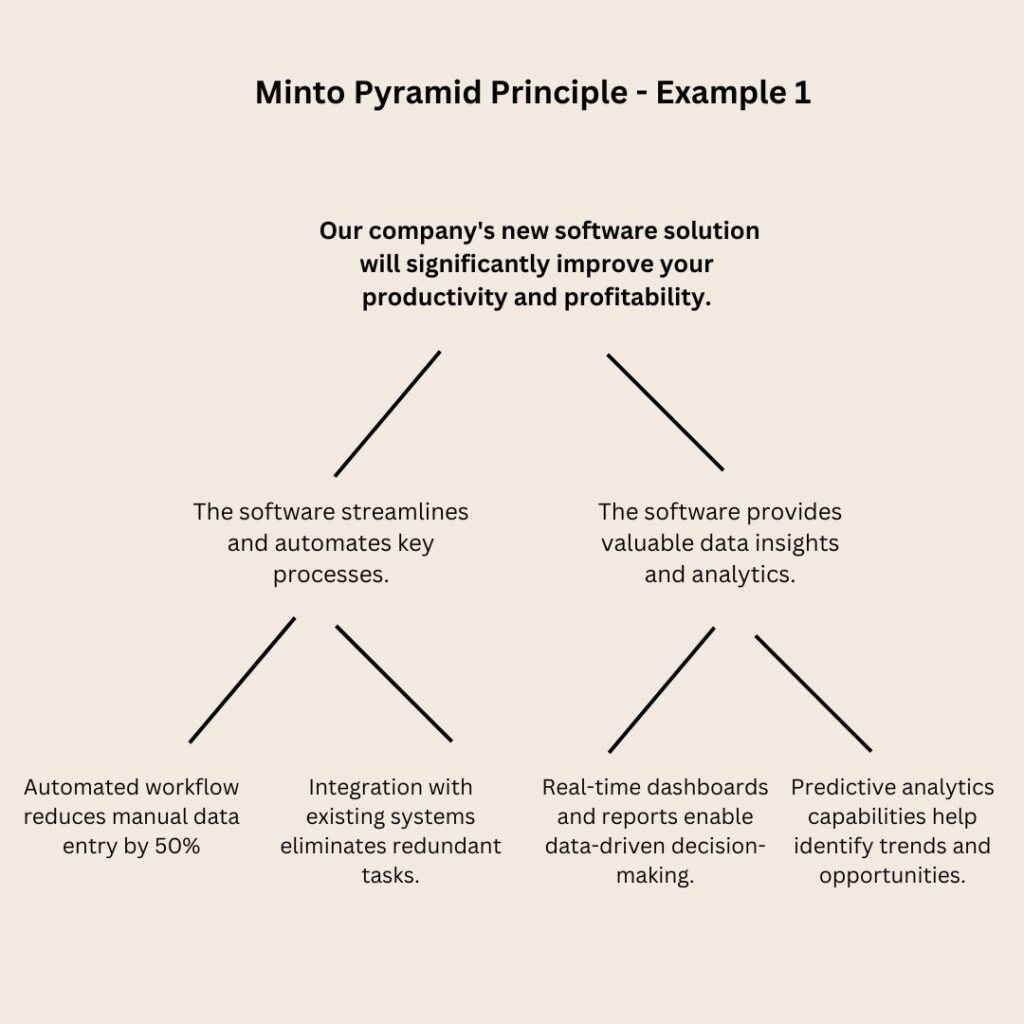Have you ever felt confused or lost when trying to communicate an idea? Maybe the message didn’t come across clearly. Or maybe you struggled to organize your thoughts logically. If so, the Minto Pyramid Principle could be a game-changer for you.
The Minto Pyramid Principle is a simple yet powerful technique for organizing and presenting information. It was developed by Barbara Minto, a former McKinsey consultant, in the 1970s. The core idea is to structure your communication like a pyramid, with the main point or conclusion at the top, supported by layers of supporting ideas and evidence below.
The Pyramid Structure Explained
Main Point/Conclusion
/ \
Supporting Idea 1 Supporting Idea 2
/ \ / \
Supporting Supporting Supporting Supporting
Evidence 1A Evidence 1B Evidence 2A Evidence 2BAt the top of the pyramid, you have the main point or conclusion you want to convey. This should be a clear, concise statement that captures the essence of your message.
Beneath the main point, you have supporting ideas or arguments that reinforce and justify the main point. These supporting ideas should be logically linked to the main point and should provide a solid foundation for it.
At the bottom of the pyramid, you have the supporting evidence or data that backs up each supporting idea. This evidence can take various forms, such as facts, figures, examples, anecdotes, or quotations.
Why Use the Minto Pyramid Principle?
There are several compelling reasons to adopt the Minto Pyramid Principle:
- Clarity and Focus: By starting with the main point, the principle ensures that your message is clear and focused from the outset. This helps your audience understand the crux of what you’re trying to communicate.
- Logical Structure: The pyramid structure imposes a logical flow and organization to your ideas, making them easier to follow and understand.
- Persuasiveness: By presenting your supporting ideas and evidence in a structured manner, the principle enhances the persuasiveness and credibility of your message.
- Efficiency: The principle encourages you to be concise and to the point, saving time for both you and your audience.
- Adaptability: The pyramid structure can be applied to various forms of communication, such as presentations, reports, emails, and even conversations.
How to Apply the Principle?
Applying the Minto Pyramid Principle involves a few key steps:
- Identify Your Main Point: Start by clearly defining the main point or conclusion you want to convey. This should be a concise, actionable statement that captures the essence of your message.
- Develop Supporting Ideas: Next, brainstorm and develop supporting ideas or arguments that reinforce and justify your main point. These should be logically linked to the main point and should provide a solid foundation for it.
- Gather Supporting Evidence: For each supporting idea, gather relevant evidence or data to back it up. This could include facts, figures, examples, anecdotes, or quotations from authoritative sources.
- Organize and Structure: Arrange your main point, supporting ideas, and supporting evidence into the pyramid structure, with the main point at the top, followed by the supporting ideas, and finally the supporting evidence at the bottom.
- Present and Communicate: Once your pyramid structure is in place, present and communicate your message, starting from the top of the pyramid and working your way down, layer by layer.
Examples and Case Studies
To illustrate the Minto Pyramid Principle in action, let’s consider a few examples:
Example 1: Persuading a client to adopt a new software solution

Example 2: Recommending a new marketing strategy

Tips for Mastering the Technique
While the Minto Pyramid Principle is relatively straightforward, mastering it takes practice and refinement. Here are some tips to help you become a pro:
- Start with the Main Point: Always begin by identifying and articulating your main point or conclusion. This will serve as the foundation for your entire pyramid structure.
- Be Selective: Choose your supporting ideas and evidence carefully. Only include information that directly supports and strengthens your main point.
- Use Simple Language: Express your ideas using clear, concise, and easily understandable language. Avoid jargon and overly complex terminology.
- Visualize the Structure: As you build your pyramid, visualize the structure in your mind or sketch it out on paper. This can help ensure that your ideas flow logically and coherently.
- Practice and Refine: The more you practice applying the Minto Pyramid Principle, the more natural and effective it will become. Don’t be afraid to revise and refine your pyramid structures until they are as clear and compelling as possible.
Minto Pyramid Principle Quiz
1. What is the core idea of the Minto Pyramid Principle?
2. What is placed at the top of the Minto Pyramid?
3. Why is the Minto Pyramid Principle considered effective for communication?
4. Which step is NOT part of applying the Minto Pyramid Principle?
5. True or False: The Minto Pyramid Principle is adaptable to various forms of communication.
TL;DR
The Minto Pyramid Principle is a powerful technique for organizing and presenting information. It involves structuring your communication like a pyramid, with the main point or conclusion at the top, supported by layers of supporting ideas and evidence below.
This approach promotes clarity, logical flow, persuasiveness, and efficiency in your communication.
To apply the principle, identify your main point, develop supporting ideas and evidence, organize them into a pyramid structure, and present your message from top to bottom.
With practice and refinement, the Minto Pyramid Principle can become an invaluable tool for effective communication in any setting.
Q&A
Q: Is the Minto Pyramid Principle only useful for written communication? A: No, the Minto Pyramid Principle can be applied to various forms of communication, including presentations, meetings, and even conversations. The pyramid structure helps organize your thoughts and ideas clearly and logically, regardless of the medium.
Q: Can the Minto Pyramid Principle be used for complex or technical topics? A: Yes, the principle is versatile and can be applied to both simple and complex topics. When dealing with technical or highly detailed subject matter, you may need to include more layers of supporting ideas and evidence within your pyramid structure. However, the core principles of clarity, logical flow, and conciseness remain the same.
Q: Is there a specific order in which the supporting ideas and evidence should be presented? A: While there is no strict rule, it is generally recommended to present your supporting ideas and evidence in a logical and hierarchical order, with the most important or compelling points coming first. This helps reinforce your main point and maintain the reader’s or listener’s interest and engagement.
Q: Can the Minto Pyramid Principle be combined with other communication techniques or frameworks? A: Absolutely! The Minto Pyramid Principle is a versatile tool that can be used in conjunction with other communication techniques and frameworks. For example, you could use the pyramid structure to organize your ideas within a larger presentation framework or storytelling narrative.
Q: Is the Minto Pyramid Principle suitable for all types of audiences? A: The Minto Pyramid Principle is designed to be universally applicable and effective for a wide range of audiences. Its emphasis on clarity, logical flow, and conciseness makes it a valuable tool for communicating with diverse groups, from technical experts to general audiences. However, you may need to adjust your language and examples to best resonate with your specific audience.





